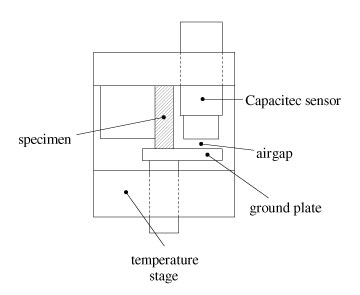Martensitic Magnetomechanical Measurements
Magnetomechanical Testing Equipment
The magnetomechanical experiments were performed using the custom built compression fixture
and temperature stage setup shown below. The specimen sat inside a small temperature stage,
visible on top, which was cooled with a supply of chilled helium gas. Compression was applied
with a lever arm in series with an Al spring by adjusting the back screw, and the load was
measured with the load cell shown to the right in the picture. A series of different springs
were used depending on applied load and specimen cross section; in this way changes in the applied
load were kept to a minimum due to changes in the sample length caused by variant rearrangement.
The entire fixture was constructed from non-magnetic materials so it would not experience any
forces or torques under applied fields. The fixture was mounted to a support bar which was fixed
between the pole pieces of a Lakeshore 2T electromagnet. The electromagnet also incorporated
an optical microscope which was centered over the specimen stage, allowing video and stills
to be taken of the experiments in situ.

Specimen strains were measured using a Capacitec capacitive displacement sensor which was built
into the specimen stage. Loads were applied to the specimen using a lever arm which pushed
on a pin which slid in a bore in the stage. The end of the pin had a plate which applied stress
to the end face of the specimen, and also acted as a ground plate for the sensor. Changes in the airgap
between the sensor and the plate due to specimen strain were converted to a strain measurement.
Capacitive sensors have high accuracy and resolution; in this experiment the sensor was calibrated
to a resolution of 2 microinches. For the specimen geometries used, this translated to roughly
7 me .
 |

Specimen
stage |
Prev Next
Magnetomechanical pages:
Go to:
My bio
Home page 



